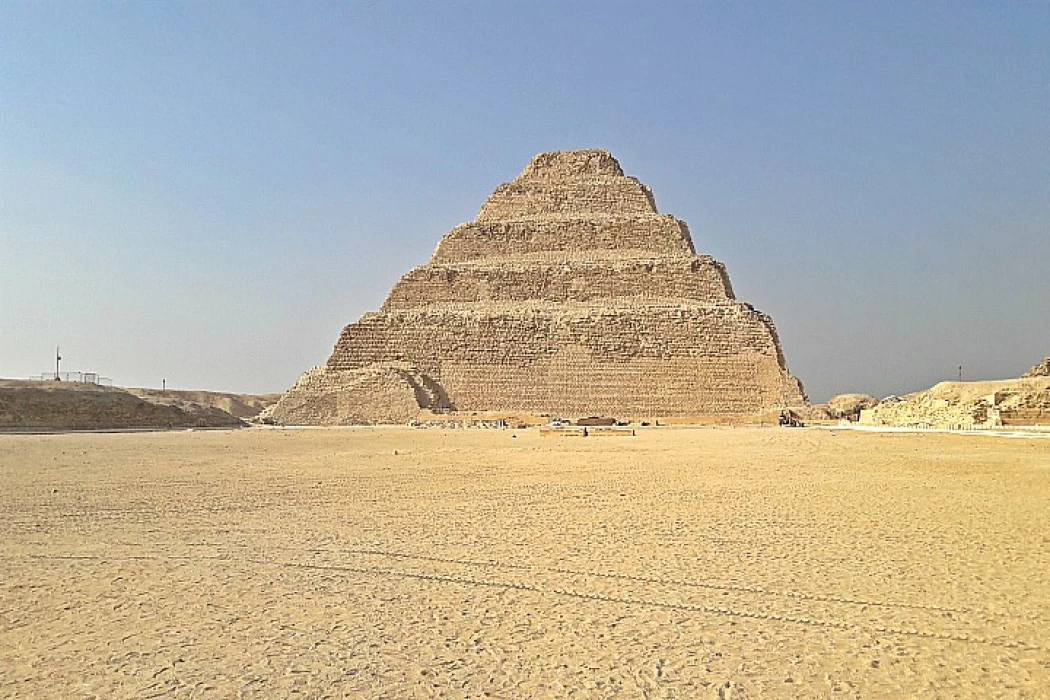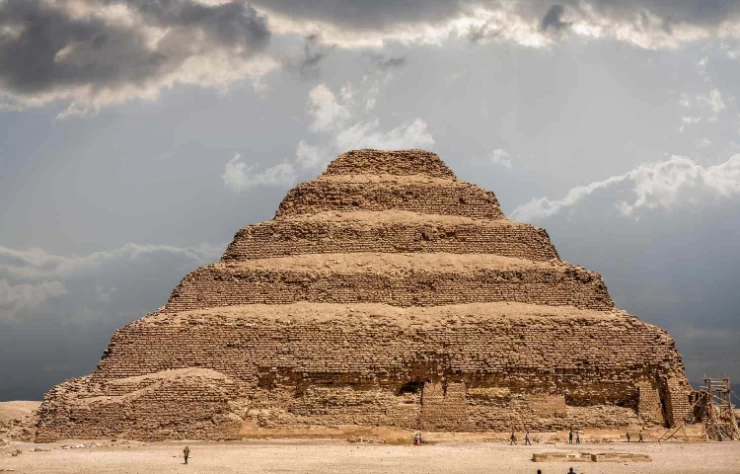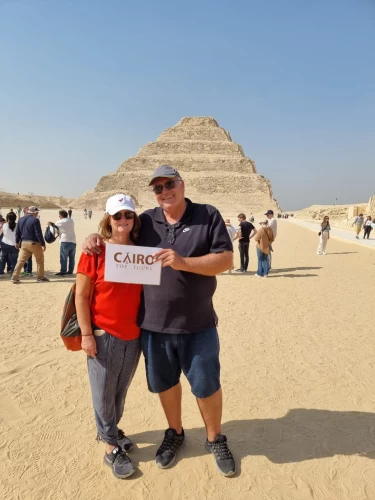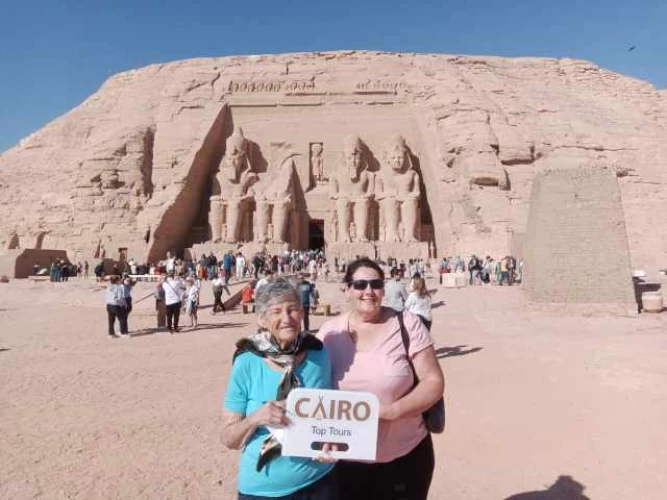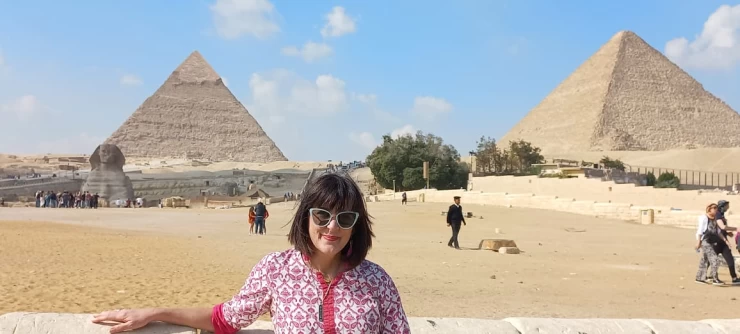Die Stufenpyramide
Das Erdbeben von 1992 hatte die innere Struktur der Pyramide schwer beschädigt. Aus diesem Grund begannen 2006 Restaurierungsarbeiten, die 14 Jahre lang in vielen Schwierigkeiten dauerten. Im Jahr 2011 wurde das Werk durch die Revolution unterbrochen. Jetzt ist es für Besucher und Touristen aus aller Welt geöffnet.
Innerhalb der Stufenpyramide
Die Stufenpyramide von König Djoser in Saqqara ist eines der Dinge die man in Kairo oder vielleicht in ganz Ägypten unternehmen kann. Diese Struktur zeigt uns die Entwicklung des Pyramidenbaus.
\Djoser Pyramide
Es ist die ursprüngliche Pyramide, die in Ägypten gebaut wurde, und obwohl es keine „echte Pyramide“ mit glatten Seiten ist, wie die Pyramiden von Gizeh und die gebogene Pyramide und die rote Pyramide von Dahshur.
Die erste großflächige Steinschnittstruktur der Welt besteht aus sechs übereinanderliegenden Stufen. Djosers Architekt beschloss, mehrere dieser Strukturen zu stapeln, um ein imposanteres Denkmal für den Pharao zu schaffen, das 203 Fuß hoch ist.
Der berühmteste Wissenschaftler, der erwähnt werden muss, wenn wir über Sakkara sprechen, ist Jean-Philippe Lauer, ein französischer Archäologe, der die beschädigten Teile des Komplexes restauriert und rekonstruiert hat.
An der Nordseite der Pyramide wird der Pyramidentempel unterschieden, während er in den folgenden Pyramidenkomplexen immer auf der Ostseite zu sehen ist. Der Stufenpyramidenkomplex ist von einer 10,5 m hohen Kalksteinmauer umgeben, die als Palastfassade bekannt ist und gebundene Schilfbündel imitiert. Die Gesamtstruktur imitiert Lehmziegel.
Die Wand hat 14 Dummy-Türen, aber nur ein richtiger Eingang in der südlichen Ecke der Ostfassade ist für die Lebenden. Die verbleibenden Türen sind als falsche Türen bekannt, die der König im Jenseits verwenden kann.
Dann betreten wir den überdachten Kolonnadengang mit einer Kalksteindecke aus ganzen Baumstämmen, die zu einer massiven Steinimitation zweier offener Türen führte. Eine Halle mit zwanzig Paaren von Kalksteinsäulen sah aus wie Bündel von Pflanzenstängeln und erreichte eine Höhe von 6,6 m. Die Säulen waren nicht freistehend, sondern an den Wandvorsprüngen befestigt.
Zwischen den Säulen auf beiden Seiten der Halle befanden sich kleine Kammern, die für jede der Provinzen von Ober- und Unterägypten gelten sollten. Am Ende der Kolonnade befand sich die Hypostyle-Querhalle mit acht Säulen, die paarweise durch Kalksteinblöcke verbunden waren. Es gibt gekrümmte Steine in der Justiz, die als Marker für das Heb-sed-Festival gelten, ein wichtiges Ritual, das ägyptische Könige nach 30 Jahren vollzogen haben, um ihre Kräfte zu erneuern.
Am südlichen Ende des Hofes befand sich eine Plattform, die über Stufen erreicht wurde. Es wurde empfohlen, dass dies ein Prinzip für den Doppelthron war. Der gesamte Stufenpyramidenkomplex symbolisiert die königliche Palastanlage und ermöglicht es dem König, die mit dem Königtum verbundenen Rituale durchzuführen. Das Südgrab lag sehr nahe am Südhof
Die Grabkammer, die derzeit während der Kairo Tagesausflüge in Ägypten nicht besichtigt werden kann, befindet sich unterhalb eines 28 Meter tiefen tiefen Schachts sowie einer Tunnelkammer und einer Galerie, die mit einem zentralen Schacht verbunden ist, dann mit dem Grabraum des Königs, der Beerdigung von Familienmitgliedern und dem Lagerung von Waren und Angeboten
Erleben Sie den Zauber Ägyptens, wo alles beginnt, mit dem professionellen Team von Cairo Top Tours. Starten Sie jetzt Ihr Abenteuer und erleben Sie den besten Urlaub in Ägypten. Sie finden hier die besten Ägypten-Osterangebote und -Urlaube 2022. Der Frühling in Ägypten ist perfekt und die Atmosphäre ist unsagbar schön.
Wir organisieren tolle und unterhaltsame Ägypten Ausflüge wie Kairo Tagestouren. Schauen Sie sich unsere Ausflüge und Reisen mit angemessenen Preisen an, die für alle Arten von Touristen im Jahr 2022 geeignet sind, sowie Ägypten Landausflüge, zusätzlich zu Kairo Tagestouren vom Flughafen und Kairo Zwischenlandung Tour. Sie können das antike Theben erkunden, beginnend mit dem Tal der Könige und dem Westufer von Luxor, sowie den Karnak-Tempel und den Luxor-Tempel. Ägypten Touren erweitern, um den Tempel von Edfu von Gott Horus der Falke, und Kom Ombo Tempel und Abu Simbel zu decken. All dies während Assuan-Tagestouren und Luxor-Tagestouren.
Das Rote Meer ist einer der Orte, die Sie in Ägypten besuchen können, genießen Sie einige Meeresabenteuer und Wanderaktivitäten malerischstenwie Hurghada Tagestouren und Sharm El Sheikh Ausflüge. Sichern Sie sich jetzt Ihren Platz in unseren Ägypten-Reisepaketen und Wüstensafari-Trips, um von Kairo aus die Oasen Siwa, Bahriya und Farafra sowie die Oasen Dakhla und Kharga zu bereisen! Wir sehen uns wieder. Wir bereiten Ihnen einen unbeschreiblichen Empfang im gesegneten Land Ägypten mit Hilfe unserer qualifizierten und hilfsbereiten Reiseleiter.
Wenn Sie etwas über Gizeh wissen und sehen möchten, wie es aussieht, finden Sie viele Informationen und Bilder eines besonderen Gebäudes, der Moschee von Taghri Bardi in Kairo. Dort erfahren Sie mehr darüber, wie Gizeh vor langer Zeit erbaut wurde.
Located in the vast expanses of Saqqara in the outer suburb of Cairo, the Step Pyramid of Djoser is indeed one of the strongest, yet most ancient, structures that Egypt boasts about. Often regarded as the first structure to implement large-scale stone construction techniques, this monumental building can be said to have spearheaded the era of pyramid construction in ancient Egypt. Built over 4600 years ago, the mysterious construction with a wide array of shapes, stories, and usages still exists and inspires archeologists, historians, and tourists to this day.
Historical background and significance
The Step Pyramid, otherwise referred to as the Pyramid of Djoser, was constructed in the 27th century BCE under the reign of the Pharaoh Djoser, who was the second monarch of Egypt's Third Dynasty. Djoser was a progressive king who wanted something more than apostolic vertical graves—mastabas—that man who is into a flat-topped tomb design created for a range of other pharaohs, including his steps. He commissioned the project to his most trusted architect, Imhotep, whom history would remember for far greater things than mere architecture.
Imhotep, who was an architect ahead of his time and the high priest, aspired to build a monument that was not only grand in the eyes of the Pharaoh but would also see a safe flight to Osiris. To achieve this, he invented a new architectural design, which was known as a step pyramid, by vertically stacking six nesting mastabas of increasingly smaller size. This great edifice not only served to elevate the status of Djoser in death but also transformed the architectural landscape of ancient Egypt forever.
The Step Pyramid measures around 62 meters (203 feet) in height, and it was the highest structure back then. Imhotep set a new trend in construction by building the pyramid with stone instead of mudbrick, which was used before. The pyramid is made up of six levels, or steps, each of which rises toward the peak of the structure, forming a staircase that is believed to help the king’s spirit ascend to heaven.
The pyramid complex is quite spacious, covering about 15 hectares (37 acres) and surrounded by a limestone wall with 14 false doors and one real door. This ingenious design had both symbolic and functional value, as it shrouded the pharaoh’s burial place in an aura of mystery and secured him from any invaders. Once inside the enclosure, one can find dozens of different buildings, such as temples and courtyards as well as the South Tomb, all of which are meant to help the deceased king reach the other world as well as serve religious practices.
Impressive underground tunnels form one of the exceptional aspects of the Step Pyramid complex. The vast stretch of 5.7 km (3.5 miles) of these vaults has more than 40, 000 stone jars engraved with the names of other kings before Djoser. The painstaking detail in the arrangement of these tunnels speaks volumes about the ideas of the ancient Egyptians concerning the protection of the treasures of the king for all time.
Imhotep, who came up with the concept of the Step Pyramid, was a Renaissance man qualified in several fields, including architecture, medicine, and religion. Because of his involvement in building the Step Pyramid, he received a lot of fame and respect. He was so influential that he was treated like a god of medical and healing arts more than a century after his death. His innovative way of using stones for construction made way for the enormous pyramids that would come after, such as the Great Pyramid of Giza.
Imhotep's design for the Step Pyramid complex also shows how much he grasps engineering with religion. The superficial step structure of pyramids represents a symbol of ascending toward the gods for the pharaohs, while the inner courtyards and temples are a representation of the cultural aspects of ancient Egyptian society rituals. This ability to balance the need for functional design and altar design envisioning the mass-transforming power of spirits reaffirms his place as one of the best architects in history.
Religious and cultural importance
Step Pyramid is a representation of sacredness in the sense that it is both a tomb and, in this case, a door to another dimension of life. The pharaohs were believed to be the people who could mingle with the gods and, thus, were considered divine. In connection with this, Djoser built the Step Pyramid to protect his divine status as well as ensure that his spirit would traverse safely into other planes of existence.
The course of the pyramid complex construction is accurate in that it shows cardinal directions and contains elements associated with the transport of the great pharaohs. The South Court, which is a large region devoid of any enclosing interior wall, was most likely enlarged in anticipation of the Heb-Sed celebration, which was a ritual that granted legitimacy to the king and spelled his right to rule. This was an opportunity for Djoser to ascertain himself as still living and well, even after he had been buried.
Furthermore, the other enclosing chapels and temples were also built for the priests, who were responsible for conducting the daily ceremonies to the spirit of Djoser, the king, and feeding him for his eternal journey. Such a practice of worshipping the dead in this manner emphasized the unending cycle of life, death, and rebirth, as was the case with the ancient Egyptians, which characterized their way of life.
The Djoser's Step Pyramid laid the foundations for a new generation of pyramids with smooth surfaces that dominated ancient Egyptian architecture. The success of Djoser’s monument brought on the following pharaohs, who commissioned larger and larger pyramids, which resulted in the Giza pyramids.
The Step Pyramid made a few improvements that would later be typical in the design of pyramid complexes. Many of these construction elements—stone quarrying, basement burial chambers, and the giant scale of the structure—were factors that pioneered the development of building pyramids. Djoser’s Step Pyramid is probably the main reason why such enormous pyramids as those of Sneferu, Khufu et al. were constructed.
For many generations, the Step Pyramid remained the symbol of the architectural accomplishment of the ancient Egyptians, but with time, it underwent much erosion. Starting from the year 1900, one British archeologist by the name of Cecil Firth made his way to Saqqara and commenced excavation works, which led to the discovery of most of the structures in the pyramid complex. Over the years, some other excavators have also managed to do a little more work at this remarkable structure.
Recently, however, restoration work has been carried out to restore the Step Pyramid for posterity. The extensive work involves, among other things, the stabilization of the internal chambers and the reconstruction of the outer walls. Such projects thankfully aim to compromise as little as possible on the original purpose of the building and allow this landmark building to testify for even more years about the culture and history of the country.
Visiting the Step Pyramid Today
Currently, tourists visiting Djoser’s Step Pyramid can enjoy not just the structure itself but the entire complex, which also reveals the elements of ancient Egyptian art and religion. Entering through the stone doors and strolling around the open sections, one can almost feel the presence of a bygone era dominated by Kings and the making of everlasting structures.
Nevertheless, Saqqara’s Step Pyramid is also one of the top places to see for every traveler, every historian, and every admirer of the undying civilization of Ancient Egypt. It is a monument of Pharaoh Djoser’s dreams as well as of the genius called Imhotep, the wonder that mankind still looks up to even after 4600 years of its existence.
